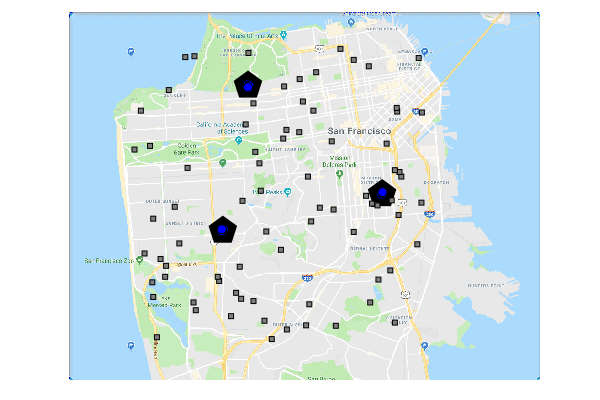Accompanying code repository for our ICRA 2020 submission 'Efficient Multi-Drone Delivery Using Transit Networks' (arXiv). In this paper, we present a comprehensive algorithmic framework to operate a large fleet of drones to deliver packages in an urban area while using transit networks to enhance their effective range. Please see the extended version on ArXiv for the formulation, algorithms, experiments, and discussions.
Below is a visualized scenario with 80 agents in San Francisco, using the bus network and other parameters as described in the paper. The black pentagons are depots, the grey rectangles are delivery locations, blue circles are drones flying, and red circles are drones riding on transit. We do not render the actual transit vehicles (buses) for clarity. Multiple drones may use a transit option simultaneously; we can only render one red circle in that case. Locations are randomly generated within a bounding box, and some of them may be slightly offshore.
Here is another example, with 110 agents, in the Washington DC Metropolitan Area:
For those of you familiar with the Julia package manager, I provide a Manifest.toml because there are two custom dependencies: my fork of Graphs.jl (which has various extensions to A*
with an implicit graph representation) and my MultiAgentPathFinding.jl,
which implements Enhanced CBS. You can also just add those repos directly and then dev this one, instead of
instantiating the environment.
Also, there are several moving parts to the code, and the two main units, graph search and multi-agent path finding have been tested themselves.
Thus, I've been a bit lazy with testing here, but I might add some basic integration tests later.
The MultiAgentAllocationTransit repository is set up as a package with its own environment in Julia (version 1.3 or later). Look at Using someone else's project at the Julia package manager documentation for the basic idea. To get the code up and running (after having installed Julia), first cd into the MultiAgentAllocationTransit folder.
Then start the Julia REPL and go into package manager mode by pressing ], followed by:
(v1.0) pkg> activate .
(MultiAgentAllocationTransit) pkg> instantiateThis will install the necessary dependencies and essentially reproduce the Julia environment required to make the package work. You can test this by exiting the package manager mode with the backspace key and then in the Julia REPL entering:
julia> using MultiAgentAllocationTransitThe full package should then pre-compile. AFTER this step, you can start IJulia (install it if you have not already) and open up the root folder:
julia> using IJulia
julia> notebook(dir="./")You can then run the multi-drone-routing-example notebook to get an idea of how to use the code for a specific domain. An overview of the code package itself is given below, after the illustrations.
I've given a brief overview of the code in the src/ folder, and an even more brief outline of the scripts/ folder. Some of the important structs and methods in the various files have additional comments. The multi-drone-routing-example notebook is a good illustration of how the code is actually used.
src/gtfs_parser.jl: Various utilities for converting the GTFS files for the transit networks into a form usable by mesrc/load_transit_env.jl: A handful of utilities for loading up the operation graph from the parsed GTFS filessrc/preprocessing.jl: Implements the functions for the two main preprocessing steps - computing the surrogate travel time estimate and the admissible heuristic on the flight distancesrc/task_allocation.jl: Implements the MergeSplitTours algorithm for the delivery sequence allocation layer.src/mapf_transit.jl: Implements everything necessary to use the Enhanced CBS Solver from MultiAgentPathFinding.jl for the MAPF-TN layer.scripts/test_*.jl: Hacked scripts for playing around. Ignore.scripts/benchmark_*.jl: The various scripts used for the results in the paper. The benchmarks should be reproducible if you parse the GTFS files (not uploaded) to the corresponding JSON files, runpreprocess_travel_time_estimates.jlto save the surrogate object that is the loaded by the benchmark scripts, and use the sameMersenneTwisteras mentioned in the script. The separatebenchmark_mult_agents_light.jlscript uses the direct flight time as the surrogate instead of the preprocessed estimate (this could have been an argument tobenchmark_multi_agents.jl, but I got lazy). Finally, note that for the arguments to thebenchmark_*scripts, you'll need some combination of the parsed GTFS files, preprocessing outputs, and parameter files (inparam_files) for the various arguments.
Note on Reproducibility
The allocation and replanning benchmarks should be straightforward to reproduce.
The one caveat is that for settings with l/m = 10, the trials would take very long much more often. Therefore, I reduced the env.threshold_global_conflicts
from 10 to 5 while running benchmarks (the solver throws an exception after 5 high-level conflicts). At some point, I'll take a deeper dive into handling many high-level conflicts better, or just have more functionality for terminating easily.
In general, it is very important to me that anyone re-running this be able to reproduce numbers/results. Please file a Github issue if you need any assistance.

